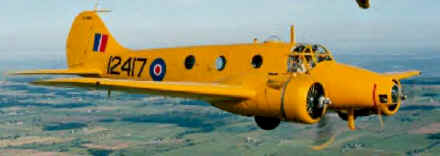|

(Photo source unknown. Please contact us if you
deserve credit.)
History:
The Avro Anson was
originally designed as a light, four-passenger civil transport and mail aircraft. The
first three were built to civil specifications, and first flew in 1935 for Imperial
Airways. However, its promise was recognized by the British Air Ministry and, in 1936, the
Avro 652A entered service with both the RAF and the RAAF (Royal
Australian Air Force) Coastal Commands, where it was the first low-wing monoplane, and the
first operational aircraft with retractable (manually) landing gear.
Named after 18th Century Royal Navy Admiral, George Anson, the Avro
Anson Mk I was used initially as a coastal patrol reconnaissance aircraft,
with a manually-operated, enclosed gun turret mounting a single .303 machine gun, two
internally-carried 100-lb bombs, and external racks that could carry eight 20-lb bombs,
flares or smoke generators. The Anson was woefully under-gunned for its task, as was
embarrassingly demonstrated when one accidentally bombed a Royal Navy submarine (H.M.S.
"Snapper") with 100-lb bombs that merely broke four light bulbs on the undersea
craft.
Thus, as quickly as possible, the Anson was replaced as a patrol craft by the
Lockheed Hudson and reassigned as a training aircraft, a role for which it proved to be
ideally suited, and in which it performed for nearly 3 decades. Initially intended to be
the standard twin-engine pilot trainer for the British Commonwealth Air Training Plan
(BCATP), the Anson II was also used for training radio operators, navigators, and
bombardiers. When Canada began manufacturing the complete aircraft at their own Federal
Aircraft LTD site, the turret was dropped from their variant.
The Anson Mk II was the first variant to be completely built in
Canada, differing from the Mk I in its Jacobs engines, hydraulically powered flaps and
landing gear, and a molded plywood nose. Fifty of the Canadian-manufactured Mk IIs were
supplied to the U. S. Army as the AT-20 crew trainer.
Subsequent Ansons manufactured in Canada under the BCATP were fitted either with
Jacobs L-6MB (Mk III) or Wright Whirlwind R-975-E3 (Mk
IV) radial engines. Canada also manufactured an Anson (Mk V)
that used plywood completely in its fuselage, which proved useful in Canadian magnetic
surveying after the war. A single gunnery training sample (Mk VI)
was built in 1943. Mark numbers VII, VIII and IX were set aside for future Canadian
varieties that never materialized, while Britain resumed manufacturing with the Anson Mk
X, which was a Mk I with a stronger cabin floor, intended for freight and
passenger use, while Marks XI and XII
saw the raising of the cabin roof for passenger comfort (both marks), and the addition of
all metal wings (MK XII, series 2), with both marks also being
produced in ambulance variations. Marks XIII, XIV, XV and XVI were assigned but never
produced, while MK XVII was never allotted.
A civilian variety of the Anson, Avro Nineteen, built on
a MK XI airframe, was produced in limited quantities for British internal routes, while
its RAF version was designated Anson C.19. A police patrol and
survey variant, the Anson C.18 was developed for both the Royal
Afghan Air Force and for the Indian government where it was to be used for civilian crew
training. A bomber trainer version, Anson T.20, was developed
for use in Southern Rhodesia, and a similar T.21 was produced,
differing primarily in the removal of a transparent nose and bomb racks, while the final
variant, the T.22, was built as a radio trainer.
With an active service life that extended from 1935 to 1952, more than 11,000
Ansons were built and one was still flying for the RAF in 1968.
Despite its obvious limitations as a weapon, the Anson's maneuverability, surprising
durability and skilled crews sometimes turned the slow, lightly armed craft into a
formidable opponent. During the evacuation of British and French forces from Dunkirk, for
instance, one of a group of Ansons pressed into service to protect the beleaguered troops
was attacked by 10 Messerschmitts, shooting down two and damaging a third before the
"dogfight" ended. Not bad for an obsolete and vastly outclassed weapon.
Nicknames: Faithful Annie; Limping
Annie; Aggie; The Flying Greenhouse.
Specifications (Mk I):
Engine: Two 350-hp Armstrong-Siddeley Cheetah IX radial piston engines.
Weight: Empty 5,375 lbs., Max
Takeoff 8,000 lbs.
Wing Span: 56ft. 5in.
Length: 42ft. 3in.
Height: 13ft. 1in.
Performance:
Maximum Speed at
7,000 ft: 188mph
Ceiling: 19,000
ft.
Range: 790 miles
Armament:
One 7.7-mm
(0.303-inch) forward firing machine gun in port side of nose, another one in dorsal
turret, plus up to 360 pounds of bombs.
Number Built: ~11,000
Number Still Airworthy: Approximately 5
Links:
Alberta Aviation Museum --
Anson page
Avro Anson Data Page
(Australia)
British Columbia Aviation Museum --
Anson Restoration
Canadian Warplane
Heritage -- Anson IV page
Duxford (Imperial War Museum) --
Anson info
Fighting the U-Boats (Anson
History)
Royal
Canadian Air Force -- Anson history

[Back to Warbird Alley's Main
Page]
All text and photos Copyright 2016 The
Doublestar Group, unless otherwise noted.
You may use this page for your own, non-commercial reference purposes only.
 |